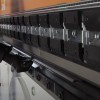The press brake is an indispensable machine for bending and shaping sheets and profiles
In the landscape of the metalworking industry it is essential to choose the right press brake for bending sheet metal and profiles. Its versatility and precision in bending metal materials make it crucial across numerous sectors, from automotive to appliance manufacturing. Nevertheless, with a wide array of options available, selecting the right press brake can prove to be challenging. In this guide, we will explore the key characteristics to consider to make an informed choice.
Processing Capacity:
The primary consideration when choosing a press brake is its processing capacity. This encompasses the maximum bending length, bending force, and maximum material thickness it can handle. Ensuring that the chosen press brake can accommodate the dimensions and thickness of the materials to be bent is essential to ensure optimal results and minimize downtime.
Maximum bending length: Ensure that the press brake can handle the length of the materials you most frequently work with.
Bending force: Verify that the press has the necessary force to bend the materials you use, also considering any future upgrades or new projects.
Maximum material thickness: Ensure that the press can bend the thickness of the materials you use without compromising the quality of the bends.
Precision and Repeatability:
Precision is paramount in many industrial applications, and the press brake is no exception. A press brake equipped with advanced controls and accurate measurement systems can ensure uniform and repeatable bends, reducing waste and optimizing production efficiency. Ensuring that the press brake can maintain tight tolerances is crucial to ensuring the quality of the final product.
Advanced controls: Look for a press brake equipped with advanced controls that allow precise adjustment of bending parameters.
Accurate measurement systems: The ability to accurately measure the position and angle of bends is essential to ensure uniform and repeatable results.
Drive Type:
Press brakes can be hydraulically, electrically, or mechanically driven. Each drive type has its own advantages and disadvantages in terms of speed, power, and control. Hydraulic press brakes typically offer greater power and versatility, while electric press brakes are often more energy-efficient and offer greater control over bending speed and precision.
Hybrid Press Brake, Hydraulic Press Brake, Electric Press Brake, or Mechanical: Evaluate the advantages and disadvantages of each drive type based on your specific needs in terms of speed, power, and control.
Safety:
Workplace safety is paramount in any industrial environment. Ensuring that the press brake is equipped with advanced safety features, such as emergency stop systems and perimeter guards, can help reduce the risk of workplace accidents and protect personnel.
Safety features: Look for a press brake equipped with advanced safety systems, such as emergency stop devices and perimeter guards, to ensure a safe working environment.
Maintenance and Support:
A press brake is a significant investment, and ensuring that it is properly maintained is essential to maximizing its lifespan and performance. Before making a purchase, check the availability of maintenance and support services from the manufacturer or authorized suppliers. Ensuring that spare parts and technical support are available can make a difference in keeping the press brake running efficiently and reliably over time.
Service assistance: Check the availability of maintenance and service assistance from the manufacturer or authorized suppliers to ensure that your press brake is maintained in optimal condition over time.
Availability of spare parts: Ensure that spare parts are available for your press brake to avoid prolonged downtime in case of failure.
Total Cost of Ownership:
Evaluate the total cost of ownership, including not only the initial purchase price but also maintenance, service, and any future upgrades.
Reviews and Feedback:
Seek reviews and feedback from other users of the press brake you are considering to gain a comprehensive understanding of the product's performance and reliability.
Compatibility with Accessories and Additional Equipment:
Verify if the press brake is compatible with accessories and additional equipment that may be necessary for your production, such as punches, dies, and automation systems.
By carefully considering each of these features and evaluating your specific needs, you will be able to choose the right press brake for your industrial operation.
Choosing the right press brake depends on several factors, including processing capacity, precision, drive type, safety, and maintenance. Carefully considering each of these aspects and assessing the specific needs of your production can help make the most informed choice possible. With the right press brake at your disposal, you can improve the efficiency, quality, and safety of the bending process, contributing to the success and growth of your industrial operation.





